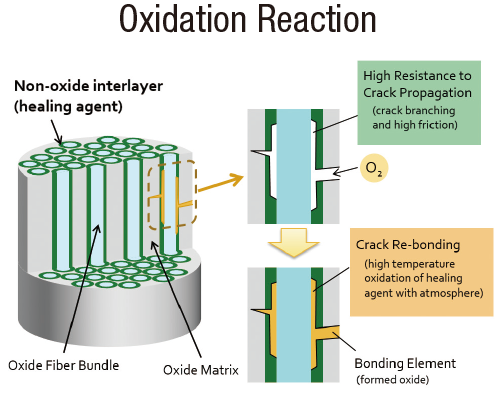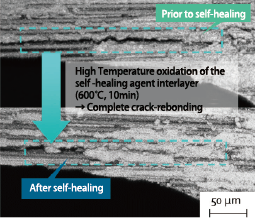Home > Highlighting JAPAN > Highlighting Japan April 2018 > Science & Technology
Highlighting JAPAN

Self-Healing Ceramics for Multiple Applications
A Japanese research team has developed a new approach to self-healing ceramic design that paves the way for structural ceramics’ use in a much wider range of fields, including turbine blades in aircraft engines.
There are materials that have so-called self-healing properties. When a crack forms in a component, it triggers a chemical reaction, and the material repairs the damage itself. In December 2017, a new type of self-healing ceramic was unveiled for use in aircraft engines. The new material in question was jointly developed by Yokohama National University (YNU), which has been involved in materials research, and the National Institute for Materials Science (NIMS), as part of a Japan Science and Technology Agency (JST) Advanced Low Carbon Technology Research and Development Program (ALCA).
“A research group at YNU discovered self-healing ceramics in 1995,” explains Professor Wataru Nakao from the YNU Graduate School of Engineering. “Although the phenomenon whereby a material can repair itself had been discovered several decades earlier, researchers often overlooked it because so many aspects of self-healing mechanisms were still unexplained back then. The fact that healing only occurred within a limited temperature range around 1,200˚C meanwhile meant that research and development was a process of trial and error initially.”
As we entered the twenty-first century, research into ways of using self-healing ceramics in products began to gather pace. Research into self-healing materials now spans various different fields, including polymeric materials and concrete.
“In the simplest possible terms, a self-healing material is an artificial material that has built-in capabilities similar to the human metabolism,” continues Nakao. “When cracks form in ceramics, oxygen gets in and causes an oxidation reaction. Over time, the heat produced by this reaction and oxide generation cause the material to expand in volume, which in turn rejoins the surface of the crack. This phenomenon is very similar to the healing process in bones, whereby inflammation and heat in the initial recovery period give way to a modification period as the bone is restored to its original state. The network of fluids inside the body, which stimulates the human metabolism, provided us with useful pointers when it came to developing self-healing ceramics. That was the key to working out how to incorporate self-healing materials into ceramics.”
Used at 1,000˚C, equivalent to the temperature of the exhaust from a jet engine, the newly developed self-healing ceramic is able to completely repair damage in as little as one minute. Given that a conventional material would take around 1,000 hours to repair itself, this represents a giant leap forwards. At present, the turbine blades in aircraft engines contain components made from alloys. If these parts could be replaced with lightweight and heat-resistant ceramics, that would translate into a projected improvement in fuel efficiency of around 15%. That is why these new materials are attracting a great deal of attention from all over the world.
“Aircraft components have to meet countless criteria for international standards and certification,” comments Nakao. “We are looking at commercialization at some point from 2030 onwards, with the aim of fitting products to the first domestically produced jet engine.”
The fact that this new ceramic exhibits self-healing properties from a temperature range of around 400˚C opens up potential applications across a whole host of industries, in addition to aircraft.
“Ceramics can be used for a wide range of purposes, because they are light and highly heat resistant,” explains Nakao. “The self-healing ceramic we have developed here could be used for contacts in automotive engines or electrical products, for example, or as a coating material. It could have even more of an impact if it were able to be used in components for satellites, or in other locations where maintenance is difficult.”
The main benefits of self-healing ceramics are that components have a longer life span and do not require maintenance. Professor Nakao and his research group are nonetheless continuing to carry out research to expand the possibilities even further.
“If we can control how components degrade, and improve self-repair capabilities, we will be able to produce materials that become stronger and more functional as they continue to heal themselves over time. This is the same principle as broken bones, which become stronger once the injury is healed. It’s also similar to items such as traditional Japanese lacquerware, or wooden structures, which increase in strength with use over many years, and improve in usability as time passes.”
Japan is a world leader when it comes to ceramic firing technology. There are high hopes that the continuing development of self-healing ceramic technology will open up new possibilities for safety and security.

© 2009 Cabinet Office, Government of Japan







